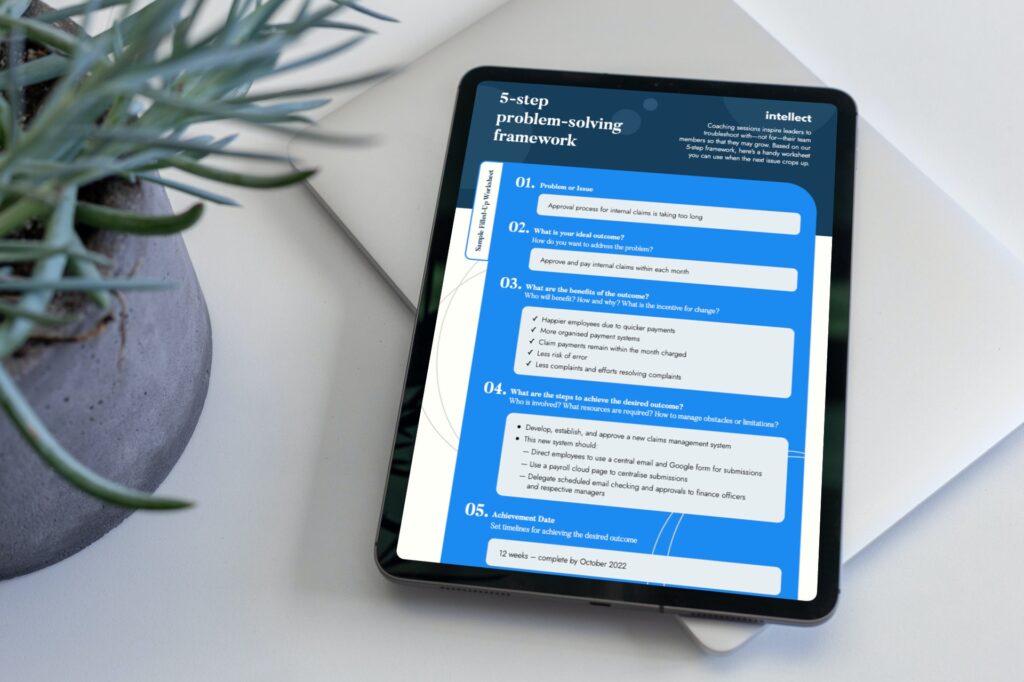All leaders are managers, but not all managers are leaders.
Managers get things done, but leaders inspire people. No wonder leadership courses are common (but not limited to) among employees on the higher rungs of an organisation.
However, mindset—the one thing that differentiates the two—is equal parts theory and practice. Real-world application is exactly where a coaching plan comes in.
In this article, we speak with leadership coach Robyn Cam to learn what leaders with coaching mindsets do differently in championing workplace mental health.
📝 We’ve also included a coaching plan template you can use at the end of this article. Click here to download it now!
What is a coaching mindset?

“Don’t bring me problems. Bring me solutions.”
We all know a leader who lives by this mantra, but it is slowly being phased out. Rather than empowering team members to solve problems independently—as this approach was intended to—it leaves them feeling stranded.
With a coaching mindset, leaders are more strategic and inclusive when solving problems. They collaborate with team members to dissect problems they are facing, map out potential solutions, and evaluate the risks and rewards of each one. This enables them to have more constructive conversations that generate win-win outcomes.
In the long run, their leadership empowers team members to adopt solution-oriented approaches to problem-solving. This sends the message that not only the upper management can effect change. Employees on the ground level can do it too. As half of companies in Singapore start to prioritise learning and upskilling, coaching has never been more important.
What does a coaching plan look like?

We put together a simplified 5-step coaching plan for managers to use to solve problems while training their team members to do so independently down the line.
It all starts with asking the right questions:
Step 1: What is the problem or issue?

Firstly, managers can work together with employees or guide them to be clear and specific when identifying a problem. This coaching question can be useful for almost every situation including workflow, morale, incompatibility, or communication issues.
“This is why coaching is for everybody,” Robyn said, “It really can go across HR, corporate, project management—that doesn’t matter. What matters is that with coaching, we create a different conversation and assess from a number of different perspectives.”
What does a clear and specific problem statement sound like? Here are two examples:
For an operational issue:
- “The current approval process for internal reimbursement is taking too long.”
For a performance issue:
- “Employee is underperforming because he feels burnt out working from home.
Localising the source of stress helps you to stay focused as you start developing a coaching plan. Nevertheless, it is helpful to note that leaders have limitations and team members dealing with emotional or sensitive matters in their personal lives should be referred to a counsellor.
Step 2: What is the ideal outcome here?

The best outcome for a company may not always resonate with the people tolling behind the scenes. But at times, the most informed strategies can come from the person who is closest to the challenge.
By allowing employees to create solutions, managers demonstrate trust and enable them to take ownership for change. If these solutions help to make things more efficient, productive, and streamlined, it’s a win-win for all.
Based on the operational issue identified in step 1, a manager or employee might see the need to develop a more efficient claims system. In step 2, a clear and specific outcome might sound like: employees should be reimbursed within the same month.
Meanwhile, if an employee is underperforming because he feels burnt out working from home, he or his manager might explore alternative arrangements. Ideally, this flexibility will give him more options while improving his work quality.
As a leader, always try to align business outcomes with employees’ goals and core values. Extrinsic motivation, like a high salary or a good benefits package, may attract talent. But intrinsic motivation retains them.
Step 3: What are the benefits of this outcome?

Now that we have identified a goal people care about, it is time to collaborate with your peers or subordinates and explore ways of working towards it.
“In problem-solving mode, most people forget to consider the company’s and manager’s perspective,” says Robyn, “In coaching, we explore how we can make this a win-win for everybody.”
Take the claims system for example. Reimbursing employees on time keeps them happy and reduces the number of complaints that upper management has to handle. That, in turn, frees up their time and energy to grow the business.
After consulting the underperforming employee, you may find that working from home is stifling for an extrovert like him and consider trying him for a few sales appointments. This would keep him engaged and his people skills could help the company convert leads. Pitching a new idea is always easier when you can paint a win-win outcome.
As you can see, coaching trains leaders to examine problems through a cost-benefit lens. This not only enhances critical thinking, but also empowers them to solve problems creatively.
Step 4: What steps can we take to achieve it?

After considering multiple viewpoints, solutions, and their incentives, bring your ideas to life with an action plan. A sound implementation plan is key to getting a manager’s approval and the buy-in of participants whose workflows may be affected.
Here are some questions to ask yourself:
- Whose buy-in do you need?
- Who will be involved in this initiative?
- How will you onboard them?
- What are the resources required?
- How can we overcome limitations?
- What are some obstacles we can foresee?
- How can we measure success?
In the first example, if the solution is a new claim management system, you will likely need approval from the Finance Officer before proposing it to the Director. Before implementation, teaching employees how to use the system and creating a foolproof guide will also make the migration more seamless.
If you’re transitioning said employee into a sales role, the action plan could entail product training and job shadowing with a senior salesperson. Ironing out the feasibility of timelines and budgets ahead of time also helps set the proposal up for success. This way, he would not be thrown into the deep end and wind up costing the company clients.
Step 5: When do we want to get it done?

Whether it’s a new system, initiative, policy, or workflow, an action plan is not complete without setting goals and timelines.
Just as an executive coach keeps leaders on track, you can do this for yourself through deadlines, updates, and intermittent reviews to assess the effectiveness of an action plan. With sufficient consultation, a timeline should be realistic, measurable, and achievable.
Don’t forget to celebrate the little wins with your team—a little motivation goes a long way.
The exponential payoff of a coaching mindset
A coaching mindset does not come about by chance. This is where managers benefit from leadership or executive coaching.
When trying to stay on top of things, they may neglect their own self-care and professional development. Regular check-ins with a coach keeps them accountable for their chosen goals.
“Coaching benefits managers, who can then influence workplace culture through their leadership and engagement,” says Robyn. “The more motivated employees are to drive success, the more time a manager has to lead and inspire.”
When managers are able to lead their teams positively while nurturing their own professional growth, their trickle effect enhances collaboration and problem-solving competencies.
Here’s how Intellect can get the ball rolling for you.








